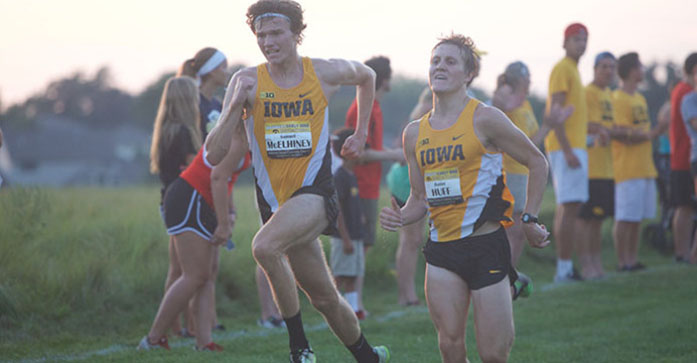There’s quite a bit to learn from the Big Ten meet last weekend.
By Adam Hensley
Big Ten cross-country teams finally got a chance to hash it out at last weekend’s conference championships.
It’s one of the three big events of the year and one of the few times Big Ten teams get a chance to compete directly with one another. There are still two huge races on the horizon — the NCAA regionals and the NCAA Championships — but the Big Ten Championship race gave a very clear image of how teams in the conference stack up this season.
The Iowa cross-country team struggled, finished 10th, dropping two places compared with 2014.
Michael Melchert was Iowa’s best runner in the meet with a time of 23:57.5, 10th in program history.
“For Melchert to be three seconds out of All-Big Ten, I think from where he was a year ago, in the 70s, it’s certainly a great step forward for him,” head coach Layne Anderson said.
Aside from the Hawkeyes, here are five takeaways from the championship meet:
1. Michigan came in as the best team in the Big Ten and proved it Sunday.
The Wolverines entered the Big Ten meet ranked fifth nationally. Led by Mason Ferlic, they did not disappoint their fans, and the senior placed second in the meet. Teammates Ben Flanagan and Tony Smoragiewicz finished close behind at eighth and ninth.
Michigan’s average time was 23:46.5, which is a little better than what the runner who finish 10th overall ran. The gap between runners was fewer than four places.
“We’ve learned that being aware of race conditions and tactics early in the race can play a vital role in where each individual finishes, and we need to be able to adapt on the fly,” head coach Kevin Sullivan said prior to the meet.
2. Usual powerhouse Wisconsin failed to run up to standards.
For years, Wisconsin has been the cream of the crop when it comes to cross-country.On Sunday, the Badgers did not bring their A-game.
The Badgers won the 2014 Big Ten meet, scoring only 47 points. It was a different story this year; the team scored 199 points.
Morgan McDonald and Joe Hardy were the top runners for Wisconsin, placing fifth and 10th. After them, the next best runner placed 41st – a significant gap.
3. Illinois and Minnesota were pleasant surprises, both heading into the meet unranked nationally. The two toppled three of the nationally ranked programs. Illinois finished second, and Minnesota placed third.
“We talked a lot about what we can control,” head coach Jake Stewart said.
Illinois’ Dylan Lafond finished third. Five more of his teammates finished in the top 30. Four freshmen placed in spots 11-45 — displaying Illinois’ potential to be a top team in the Big Ten for years to come.
Minnesota was led by its seniors; Adam Zutz and Aaron Bartnik finished seventh and 12th.
Both teams jumped up four spots from their 2014 finishes.
4. Purdue has a special runner in Matt McClintock. The senior Boilermaker won the Big Ten meet with a time of 23:12.1, more than seven seconds faster than second place.
Without their senior, Purdue would not have finished at seventh place in the meet. Its next runner, Tate Schienbein, finished 39th. McClintock single-handedly brought Purdue to its finish. Running enthusiasts should look forward to what he can bring come regionals.
5. The Big Ten now owns the Great Lakes Region. Following Sunday’s meet, regional rankings came out on Monday, and the Big Ten owns the top of the list.
Six of the top seven teams are Big Ten: Michigan, Indiana, Michigan State, Purdue, Wisconsin, and Ohio State.
The talent level is there, and it seems as though for years to come the rankings should not differ. All of the teams have young talent and are hungry to prove they can succeed.



